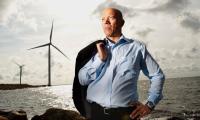
An interview with Jan hylleberg
Jan Hylleberg is CEO of the Danish Wind Industry Association since 2008 and is also on the board of directors for WindEurope (former European Wind Energy Asso-ciation). With more than a decade of experience, he knows the do’s and don’ts of starting large scale wind power projects.
What is the most important development in Danish Wind Industry the past ten years?
“Cost reduction in developing wind parks. This happened at a greater speed than ex-pected, which is very positive. Finding investors to pay for the technology and to become less dependent of subsidy, has gone very well. In the years to come, there will be projects conducted subsidy free. The industry as such has consolidated and today, the offshore industry and sector have become a global industry and sector.”
Why is it important to understand the interests of the wind power developers in rela-tion to the North Sea Wind Power Hub?
“These are the people who invent and develop the market. They have a lot of practical experience, which means they understand the risks and challenges involved in building and running an offshore wind farm. So it is important to keep them involved.”
Which lessons learned about wind power in Denmark, can be useful for the North Sea Wind Power Hub consortium?
“Being the first in offshore wind, we learned how to develop project pipelines and how to get the best out of the potential. Also, the Danish Government improved the permitting procedure for starting offshore wind power projects by creating a one-stop-shop approach. This means that permission applications for offshore wind power can be handled through one agency that represents government authority and local authority. This limits risks in the development process and makes it simpler and thereby also cheaper.”
What is your opinion about internationally coordinated offshore wind power solu-tions?
“There is no doubt that we need collaboration between countries and governments to have the full potential of the North Sea and Baltic Sea, in order to build a fossil free future. In the years to come, we have to develop new ways of exploring offshore wind. The challenge is to coordinate using the full potential without raising international conflicts of interest. This requires caution. That is why regional coordination and collaboration is the starting point, with countries neighboring the North Sea. Then it will probably expand.”
What is your vision of the North Sea Wind Power Hub?
“This concept has great potential. Enough offshore wind energy could be produced in the North Sea alone to cover European Union electricity needs several times over. We need a massive infrastructure in the North Sea to realize it. Also, it appeals to our capability of thinking out of the box. The North Sea Wind Power Hub is bringing together the brain power of many Europeans, thinking in a whole new context. We will welcome all discussions and dialogue, in order to realize the best solution possible.”
When it comes to industry engagement for the North Sea Wind Power Hub, what are the most important challenges?
“Getting the industry to the table is a challenge, because they have to invest time in devel-opment of offshore wind solutions. In order to do so, companies will have to understand what they can gain by it. If the goal for them is too abstract, too far away because of many decisions and proposals that have to be made, they will be hesitant to join. Then, when they are willing to explore opportunities together, it is important to have structure in the organization. It should be clear who makes decisions and who takes responsibility for the activities of the consortium.”
Is there anything else you would like to add to this interview or the NSWPH newslet-ter?
“I think we are entering a very important era. In the next few years, all the systems needed to explore the potential of the North Sea have to be put in place. This project is huge and very important. The industry needs a clear strategy as soon as possible, so that we can meet the international climate goals for 2030 – as well as 2050.”
